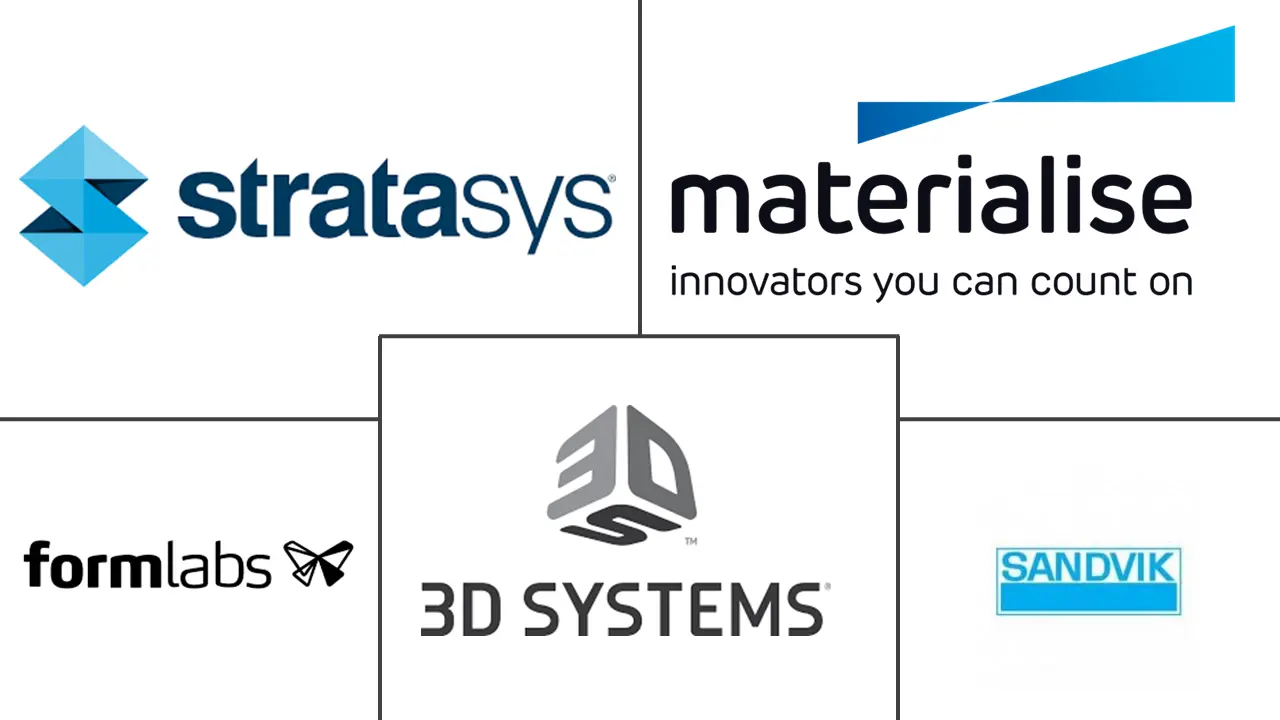Asia Pacific 3D Printing Market Size and Share
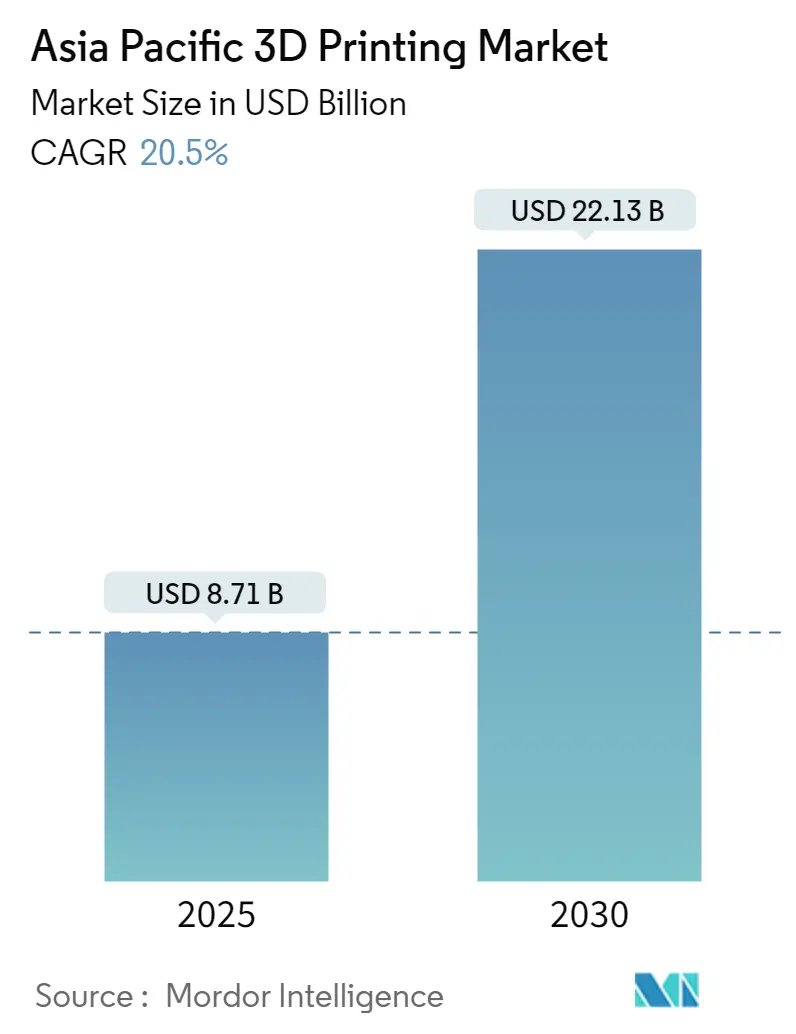
Asia Pacific 3D Printing Market Analysis by Mordor Intelligence
The Asia Pacific 3D Printing Market size is estimated at USD 8.71 billion in 2025, and is expected to reach USD 22.13 billion by 2030, at a CAGR of 20.5% during the forecast period (2025-2030).
- 3D printing, or additive manufacturing, makes three-dimensional objects by adding material layer by layer based on a digital design or model. It is called "additive" as the object is built from scratch instead of "subtractive" processes like cutting or drilling material away. The process of 3D printing comprises several steps. First, a virtual design of the object is created using computer-aided design (CAD) software or a 3D scanner. This design serves as a blueprint for the 3D printer to read. The virtual model is then prepared for printing by breaking it into many layers using specialized software. The 3D printer follows these instructions and adds material layer by layer to create the physical object. The 3D printing market in Asia-Pacific has experienced significant growth and is poised to continue expanding in the coming years. This emerging technology has revolutionized various regional industries, including manufacturing, healthcare, aerospace, and automotive.
- One of the prominent factors driving the development of the 3D printing market in Asia-Pacific is the increasing adoption of additive manufacturing technologies by significant industries. With countries like Japan, China, Singapore, and South Korea at the forefront of technological advancements, companies in these regions are investing heavily in 3D printing to improve their production processes and achieve a competitive edge. Moreover, the favorable government initiatives promoting research and development and the availability of skilled labor further contribute to the market's growth.
- The healthcare industry in Asia-Pacific has also embraced 3D printing technology. The ability to create customized medical devices, prosthetics, and implants has revolutionized patient care and treatment outcomes. Additionally, 3D bioprinting has gained traction in the region, allowing for the creation of tissues and organs for transplantation, potentially addressing the growing demand for organ donations.
- To that extent, in December 2023, a joint research and development lab in additive manufacturing, a tie-up between Nanyang Technological University and Singapore General Hospital, announced that it is working on healthcare innovations such as bioprinting living tissues and customizing medical devices and implants. The collaboration leverages the expertise and resources of SGH's 3D Printing Centre and NTU's Singapore Centre for 3D Printing. The lab would also focus on developing abilities for 3D printing medical implants directly at the point of care and enhancing the 3D healthcare technology landscape.
- The automotive and aerospace sectors have also witnessed an increased adoption of 3D printing in Asia-Pacific. The technology facilitates manufacturing lightweight and complex components, decreasing the overall costs and enhancing fuel efficiency. Further, 3D printing aids rapid prototyping, enabling quicker design iterations and lowering the time to market.
- However, many businesses and individuals in the region are still unfamiliar with the capabilities and benefits of 3D printing technology, leading to a slow uptake. Additionally, the high cost of 3D printers and materials remains a significant barrier, limiting access for small and medium-sized enterprises. Intellectual property concerns and the absence of robust regulations pose challenges, creating uncertainties and limiting innovation.
- Also, the macroeconomic trends in Asia-Pacific have a prominent impact on the 3D printing market. With the rapid economic growth in countries like India and China, there has been an increased demand for innovative technologies, including 3D printing. This has led to a surge in investments in the studied market. For instance, in January 2024, metal 3D printing service provider 3DEO announced that it received a significant investment from Seiko Epson Corporation (EPSON) and the Development Bank of Japan Inc. (DBJ). Described as a 'pivotal step' in the Los Angeles-based company's expansion, the investment seeks to support 3DEO's growth strategies in Japan and North America, particularly for additive manufacturing (AM) applications in the aerospace, semiconductor, medical devices and equipment, and industrial markets.
Asia Pacific 3D Printing Market Trends and Insights
The Automotive Segment is Expected to Drive the Market's Growth
- 3D printing technology has the potential to transform traditional manufacturing processes, offering new opportunities for innovation, customization, and cost-effectiveness in the automotive industry. One of the prominent advantages of 3D printing in the automotive segment lies in its capability to produce prototypes and iterate design concepts rapidly. Using 3D printing, automakers can create intricate and precise models, allowing for faster product development. This enables engineers to test different design iterations, assess performance, and make necessary modifications without requiring costly and time-consuming traditional manufacturing methods.
- 3D printing holds enormous potential for customization and personalization in the automotive industry. By harnessing this technology, automakers can produce bespoke parts and components tailored to individual customers' preferences. 3D printing allows for greater customer satisfaction and brand differentiation, from personalized interior trims to unique exterior accessories.
- The automotive industry faces challenges in the availability and cost of spare parts, especially for older or rare car models. 3D printing offers a solution by providing a cost-effective method for manufacturing spare parts on demand. This not only reduces lead times but also eliminates the need for expensive inventory storage. Also, 3D printing facilitates the production of complex geometries that may be challenging to achieve utilizing traditional manufacturing methods.
- The increasing automotive demand and production in Asia-Pacific will likely offer lucrative opportunities for market growth. For instance, according to the German Association of the Automotive Industry (VDA), China is the largest automobile market globally in terms of supply and demand. China's automobile registrations ascended to around 25.8 million units in 2023, representing a rise of approximately 11% compared to 2022.
- According to the China Association of Automobile Manufacturers(CAAM), in August 2023, around 2.3 million passenger cars and 310,000 commercial vehicles were sold in China, an increase compared to the previous month.
- Further, according to the Society of Indian Automobile Manufacturers (SIAM), in 2023, the total production volume of vehicles in India was approximately 25.93 million units. The increasing demand and production in the automotive sector across various regions worldwide is likely to aid the growth of the market.
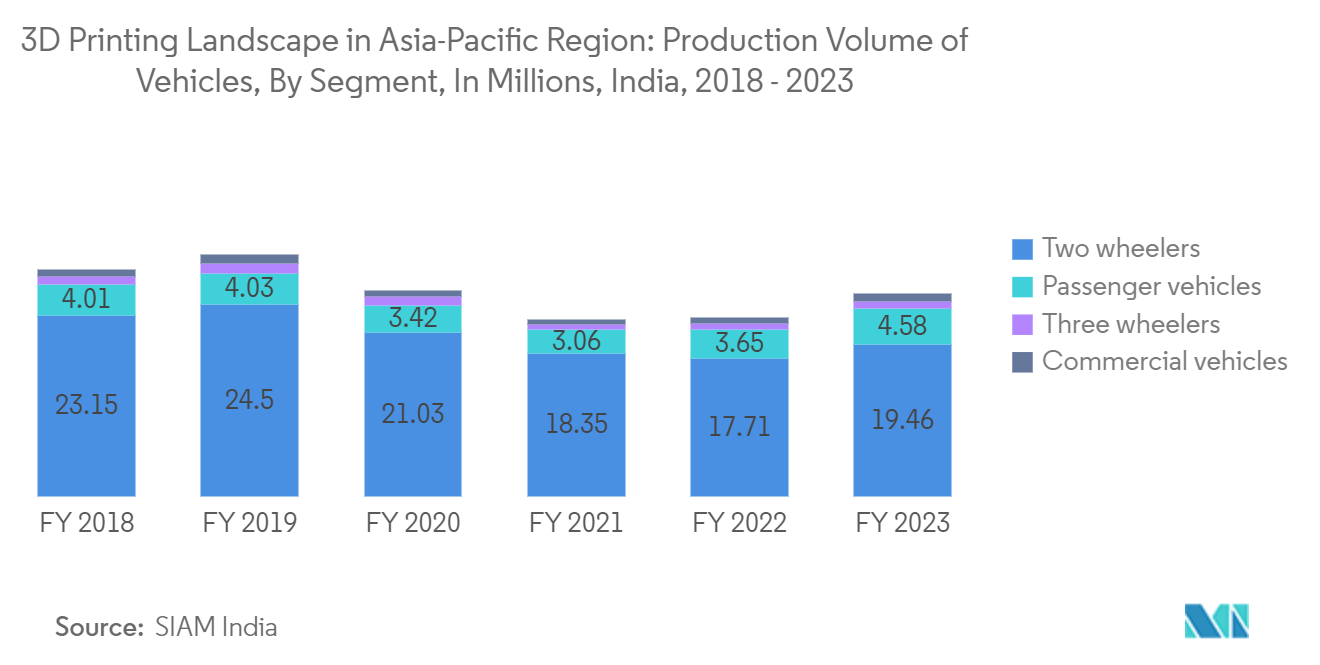
China is Expected to Hold a Major Market Share
- The 3D printing market in China has witnessed rapid growth in recent years. This emerging technology has revolutionized traditional manufacturing processes, offering significant advantages in cost-effectiveness, customization, and efficiency.
- In March 2024, scientists from a collaboration between Zhang Zhenjun and Zhang Zhefeng from the CAS Institute of Metal Research's Shenyang National Laboratory for Materials Science and Robert Ritchie from the University of California, Berkeley made an advancement in 3D printing technology for a titanium alloy, doubling the material's endurance and broadening prospects for its applications in the aerospace sector. This process produced a pore-free alloy with a 106% increase in tensile fatigue strength, from 475 MPa to a world-record 978 MPa. By employing a process that includes hot-isostatic pressing (HIP) and high-temperature-short-time (HTSt) heat treatment, the researchers were able to eliminate microvoids, commonly formed during the printing process, and restore a nearly void-free microstructure to the titanium alloy. Such advancements are likely to offer a significant boost to the growth of the market.
- China has made substantial strides in developing advanced 3D printing technologies, increasing adoption across various industries. Significant investments in research and development have allowed Chinese companies to create advanced 3D printing technologies, including metal printing and bioprinting. These technological advances have facilitated the production of complex and high-quality objects, driving the demand for 3D printing solutions.
- 3D printing provides a cost-effective alternative to traditional manufacturing methods, especially for small-scale production and prototyping. By eliminating the requirement for expensive molds and tooling, 3D printing significantly reduces production costs. This cost advantage has attracted numerous Chinese manufacturers, especially in the aerospace, automotive, and electronics industries, where prototyping and customization are crucial.
- In August 2023, global consumer electronics company Apple Inc. announced using metal 3D printing technology from Chinese 3D printer manufacturers Farsoon Technologies and Bright Laser Technologies (BLT) to produce critical components for its new smartwatches. Further, China-based binder jet 3D printer manufacturer EasyMFG demonstrated 3D smartwatch casings printed in 316L stainless steel using its binder jetting technology. This highlights the growing adoption of metal 3D printing to produce smartwatches.
- According to the National Bureau of Statistics of China, the retail sales value of household appliances and consumer electronics in China in January/February 2024 amounted to nearly CNY 131 billion (USD 18.02 billion), CNY 128 billion (17.61 billion) in January/February 2023. The increasing demand for consumer electronics in China will likely aid the market's growth.
- The 3D printing market in China has witnessed significant diversification across various industries. Initially, the technology was primarily used in prototyping and small-scale production. However, with materials and printing technology advancements, 3D printing is now being adopted in the healthcare, construction, and education sectors. This diversification has created new opportunities for 3D printing companies and has contributed to the overall market growth.
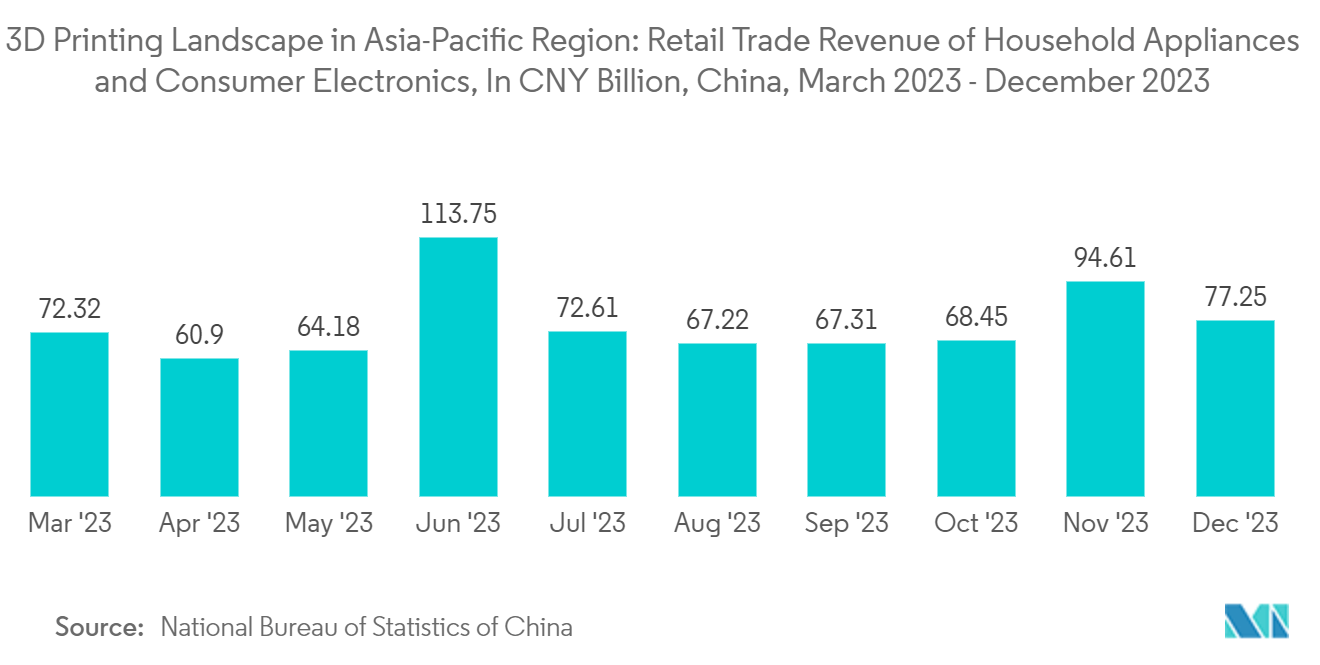
Competitive Landscape
The 3D printing landscape in Asia-Pacific is semi-consolidated, with the presence of players occupying a moderate level of market share. Some players are Stratasys, 3D Systems, EOS, HP, GE, Formlabs, Optec, Carbon, Renishaw, Desktop Printer Manufacturers, and Ultimaker. The market players are striving to innovate new products through extensive investments in R&D, collaborations, and mergers to cater to the evolving demands of consumers.
January 2023 - Indian Institute of Technology (IIT) Tirupati and Kyndryl India collaborated to enhance the AI-enabled 3D printing technology for the manufacturing sector in India. The collaboration aims to develop cost-effective 3D prototypes for complex products in manufacturing quickly. The collaboration combines IIT Tirupati’s domain knowledge in 3D printing with Kyndryl’s global expertise in artificial intelligence to enable the co-creation of machine learning models that allow for near real-time identification of potential defects during 3D printing.
January 2023 - A Chinese startup, TOP. E, focused on making batteries utilizing 3D printers, developed a battery-making technology employing its own 3D printers and 3D printing technology. The company claims its 3D-printed electrodes can radiate heat more efficiently than conventionally made electrodes.
Asia Pacific 3D Printing Industry Leaders
-
Stratasys, Ltd.
-
Sandvik AB
-
3D Systems, Inc.
-
Materialise NV
-
Formlabs
- *Disclaimer: Major Players sorted in no particular order
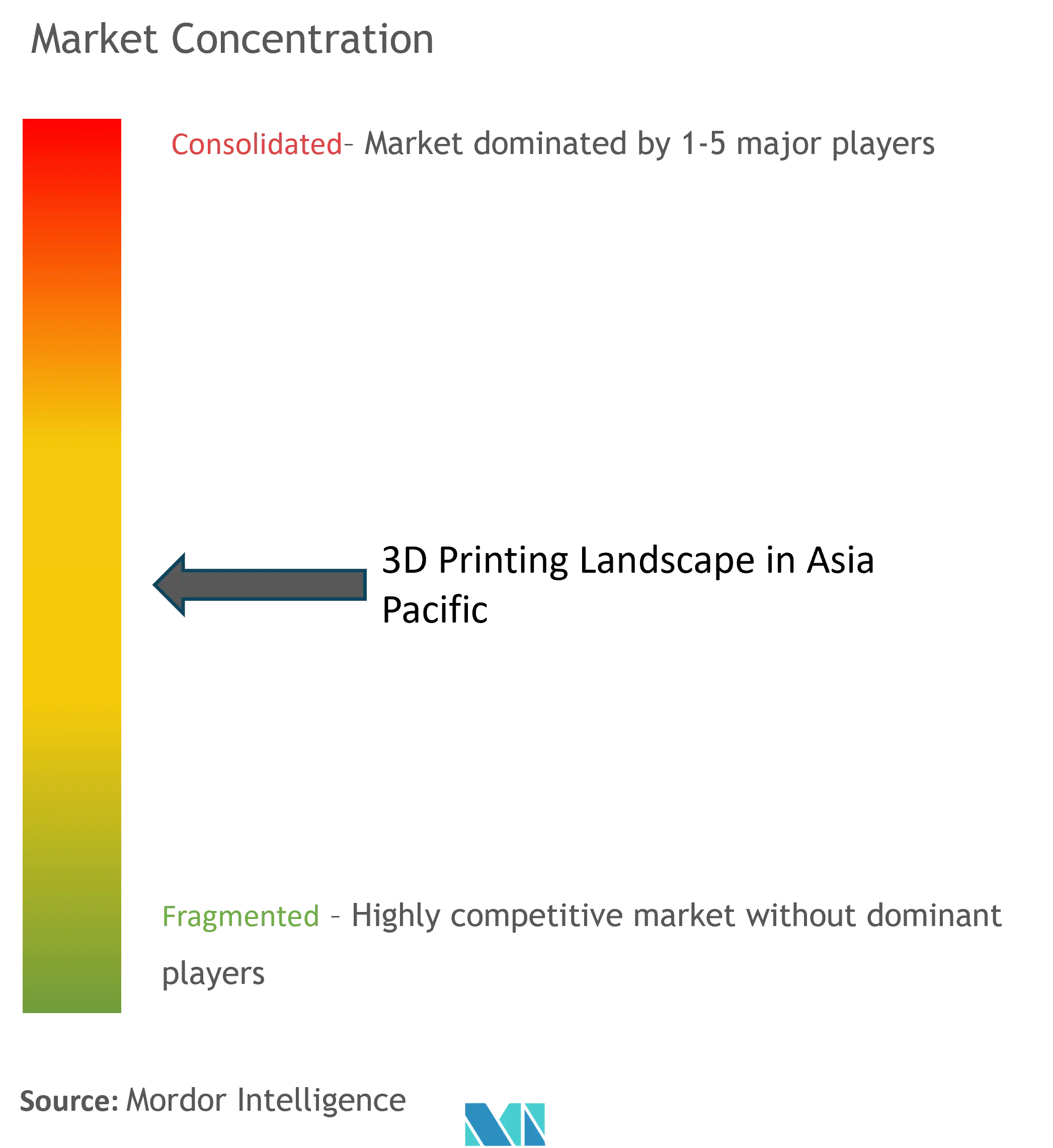
Recent Industry Developments
- January 2024: STPL3D, a segment of Sahajanand Technologies Pvt. Ltd made expansions to its 3D printing portfolio, showcasing the introduction of its Made in India SLS 3D Printer, which claimed to be designed to elevate the precision, scale, and efficiency of 3D printing. This machine includes a 500 x 500 x 500 mm build volume and a Co2 laser with 100 W power.
- August 2023: AddUp announced that the Indian Space Research Organisation (ISRO) expanded its aerospace and 3D printing abilities by purchasing a Magic 800 Directed Energy Deposition (DED) machine. AddUp launched the Magic 800 in early 2023, and it is one of its portfolio's largest 5-axis, CNC, blown powder DED machines. The system also has two exchangeable heads, a 2-kW laser, and a build volume of 1,800 x 1,000 x 1,000 mm. It is based on an enclosure inverted design, which facilitates working with reactive powders.
Asia Pacific 3D Printing Market Report Scope
3D printing, or additive manufacturing, creates three-dimensional objects by adding material layer by layer based on a digital design or model. It is called "additive" as the object is built from scratch instead of "subtractive" processes like cutting or drilling material away.
The 3D printing landscape in Asia-Pacific is segmented by hardware (material extrusion/FDM, vat photopolymerization [SLA, DLP, and CLIP], power bed fusion [SLS, EBM, and SLM], material jetting, DED, and binder jetting), end-user industries (aerospace and defense, healthcare, automotive, electronics/electro-mechanics/consumer products, construction, education, art and fashion, and other end-user industries), application (prototyping, tooling, manufacturing, and other applications), materials (metals [ferrous, non-ferrous, precious, and refractory], polymers [resin, powder, filament, and pellets], ceramics [oxide, non-oxide, glass, and bio ceramic], construction [concrete, composite, and sustainable]), form factor (solid [filaments and pellet] and powder), and country (China, India, Japan, South Korea, and Rest of Asia-Pacific). The market sizes and forecasts are provided in terms of value (USD) for all the above segments.
| Material Extrusion/FDM |
| Vat Photopolymerization (SLA, DLP, and CLIP) |
| Power Bed Fusion (SLS, EBM, SLM etc.) |
| Material Jetting |
| DED |
| Binder Jetting |
| Aerospace and Defense |
| Healthcare |
| Automotive |
| Electronics/Electro-mechanics/Consumer Products |
| Construction |
| Education |
| Art and Fashion |
| Other End-user Industries |
| Prototyping |
| Tooling |
| Manufacturing |
| Other Applications |
| Metals (Ferrous, Non-ferrous, Precious, and Refractory) |
| Polymers (Resin, Powder, Filament, and Pellets) |
| Ceramics (Oxide, Non-oxide, Glass, and Bio Ceramic) |
| Construction (Concrete, Composite, and Sustainable) |
| Solid (Filaments and Pellets) |
| Powder |
| China |
| India |
| Japan |
| South Korea |
| Australia and New Zealand |
| By Hardware | Material Extrusion/FDM |
| Vat Photopolymerization (SLA, DLP, and CLIP) | |
| Power Bed Fusion (SLS, EBM, SLM etc.) | |
| Material Jetting | |
| DED | |
| Binder Jetting | |
| By End-user Industries | Aerospace and Defense |
| Healthcare | |
| Automotive | |
| Electronics/Electro-mechanics/Consumer Products | |
| Construction | |
| Education | |
| Art and Fashion | |
| Other End-user Industries | |
| By Application | Prototyping |
| Tooling | |
| Manufacturing | |
| Other Applications | |
| By Materials | Metals (Ferrous, Non-ferrous, Precious, and Refractory) |
| Polymers (Resin, Powder, Filament, and Pellets) | |
| Ceramics (Oxide, Non-oxide, Glass, and Bio Ceramic) | |
| Construction (Concrete, Composite, and Sustainable) | |
| By Form Factor | Solid (Filaments and Pellets) |
| Powder | |
| By Country*** | China |
| India | |
| Japan | |
| South Korea | |
| Australia and New Zealand |
Key Questions Answered in the Report
How big is the Asia Pacific 3D Printing Market?
The Asia Pacific 3D Printing Market size is expected to reach USD 8.71 billion in 2025 and grow at a CAGR of 20.5% to reach USD 22.13 billion by 2030.
What is the current Asia Pacific 3D Printing Market size?
In 2025, the Asia Pacific 3D Printing Market size is expected to reach USD 8.71 billion.
Who are the key players in Asia Pacific 3D Printing Market?
Stratasys, Ltd., Sandvik AB, 3D Systems, Inc., Materialise NV and Formlabs are the major companies operating in the Asia Pacific 3D Printing Market.
What years does this Asia Pacific 3D Printing Market cover, and what was the market size in 2024?
In 2024, the Asia Pacific 3D Printing Market size was estimated at USD 6.92 billion. The report covers the Asia Pacific 3D Printing Market historical market size for years: 2022, 2023 and 2024. The report also forecasts the Asia Pacific 3D Printing Market size for years: 2025, 2026, 2027, 2028, 2029 and 2030.
Page last updated on:
Asia Pacific 3D Printing Market Report
Statistics for the 2025 Asia Pacific 3D Printing market share, size and revenue growth rate, created by Mordor Intelligence™ Industry Reports. Asia Pacific 3D Printing analysis includes a market forecast outlook for 2025 to 2030 and historical overview. Get a sample of this industry analysis as a free report PDF download.
